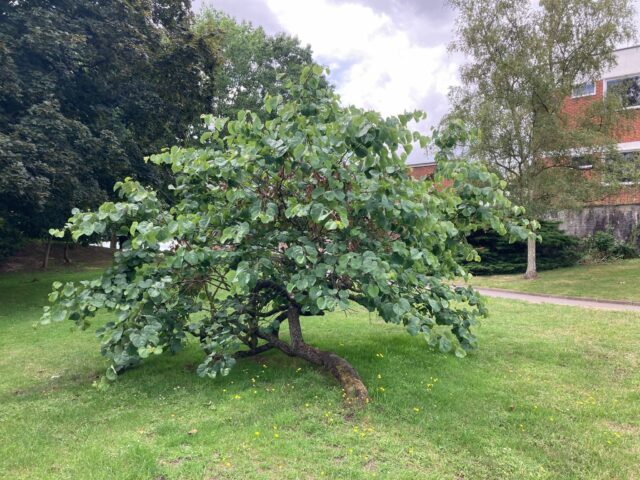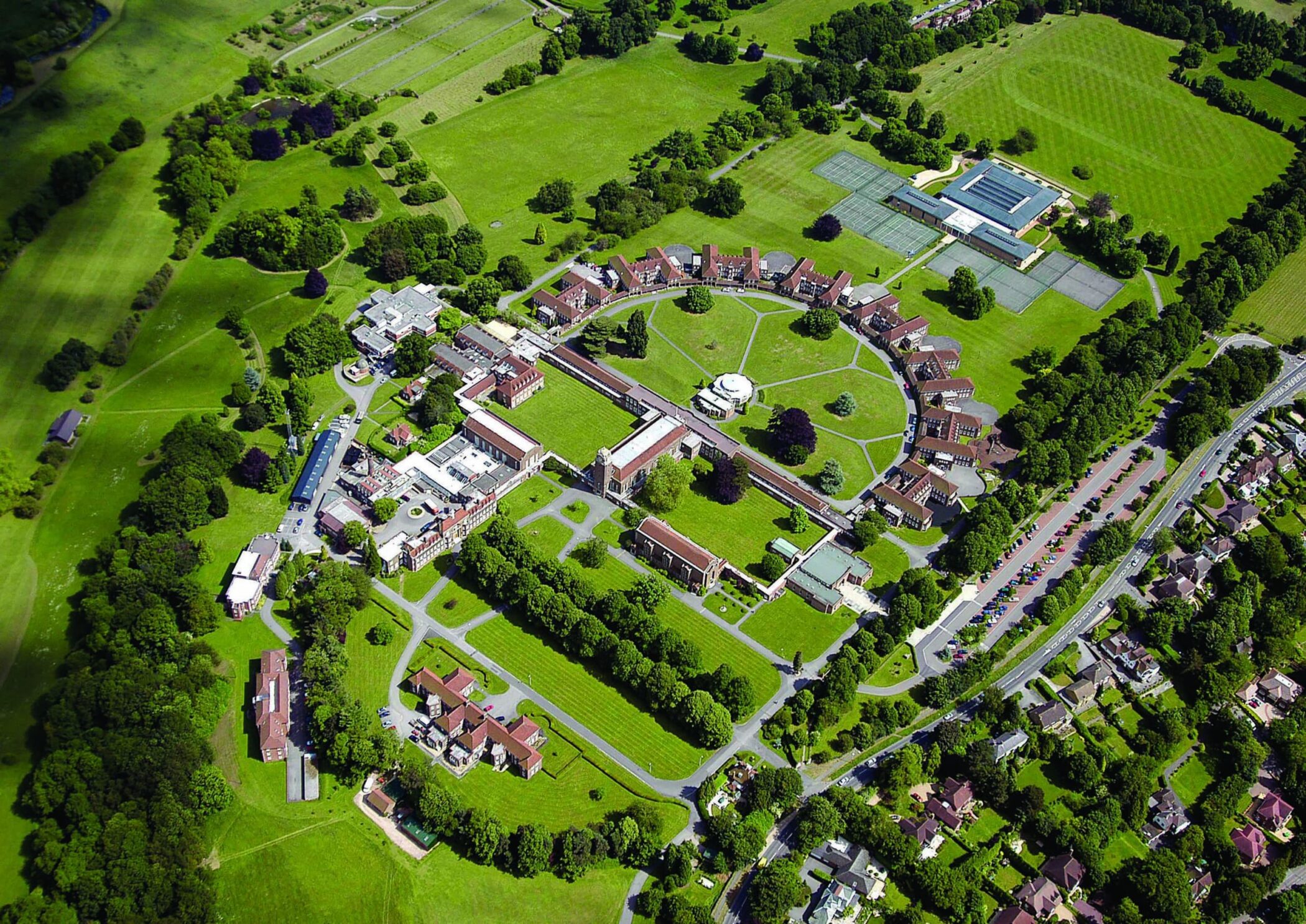Welcome to the online home of the RMS Tree Trail.
We are pleased to bring you a self-guided walk around some of RMS’ most notable trees. The trail takes you around 23 stations. As you walk the trail, look out for the tags fixed to the trunk of each tree. If you have a smartphone handy, you can scan the tag’s QR code which will load a page with further information on that tree.
You can also download a map HERE.
History of the Tree Trail
The first two tree trails were created in the school year 1987-88 by students in the “Second Year” who have studied trees as part of their Science programme.
The tree trails were updated in 2009 with the help of Mr Billy Lees, Head of Estates, and in 2013 they were merged into one trail. The 2013 tree trail was named after the founder of the school: Chevalier Ruspini as we celebrated the 200th anniversary of his death by dressing up in Regency-style clothing and enjoyed an 18th-century lunch menu and took part in period activities.
Over the years, some trees were lost and others were planted.
In 2022-23 another update took place with included the addition of QR codes to mark each station in the current tree trail allowing a wider range of audience to appreciate the beauty of our school grounds.
1. Silver birch (Betula pendula “youngii”)

A tree planted in memory of Mr Neil Young who was Head of Classics at RMS between 1992-2019. His old classroom is directly opposite of this tree where Latin studies were brought to life by his engaging teaching style.
Silver birch trees can be easily recognised by their silver-white bark and they are common in the UK. The light green, small and triangular-shaped leaves have a toothed edge, and they fade to yellow in autumn. Silver birch is monoecious, meaning both male and female flowers (catkins) are found on the same tree, from April to May.
2. Oak (Quercus robur) called the Queen of the Park

A tree planted in 2022 for the Queen’s Platinum Jubilee.
We had an oak tree with the same title in almost the same place in the past, but it unfortunately had to be cut down when the Library/ Resource Centre was built, so we are delighted to have the Queen of the Park back.
The ruling majesty of the woods, the wise old English oak holds a special place in our culture, history, and hearts. It supports more life than any other native tree species in the UK; even its fallen leaves support biodiversity.
Watch out for the lobed leaves that grow in bunches after mid-May and the Long, yellow hanging catkins (flowers) which distribute pollen into the air. As it ripens, the green acorn turns brown, loosens from the cupule and falls to the canopy below, sprouting the following spring.
3. Wellingtonia or Giant Redwood (Sequoiadendron giganteum)

Giant redwood is the sole living species in the genus Sequoiadendron, and one of three species of coniferous trees known as redwoods. They are the most massive trees on Earth which occurs naturally only in groves on the western slopes of the Sierra Nevada mountain range of California. The giant sequoia is listed as an endangered species by the IUCN, with fewer than 80,000 trees remaining.
Giant sequoia specimens are the most massive individual trees in the world. They grow to an average height of 50–85 m (164–279 ft) with trunk diameters ranging from 6–8 m (20–26 ft). Giant sequoias are among the oldest living organisms on Earth. The bark is fibrous, furrowed, and may be 90 cm (3 ft) thick at the base of the columnar trunk. The sap contains tannic acid, which provides significant protection from fire damage. The leaves are evergreen, awl-shaped, 3–6 mm (1⁄8–1⁄4 in) long, and arranged spirally on the shoots.
The giant sequoia regenerates by seed. The seed cones are 4–7 cm (1+1⁄2–3 in) long and mature in 18–20 months, though they typically remain green and closed for as long as 20 years. Each cone has 30–50 spirally arranged scales, with several seeds on each scale, giving an average of 230 seeds per cone.
4. Cedar of Lebanon (Cedrus libani)

Cedar is a majestic, evergreen conifer which can grow to 35m. The bark is blackish-brown with closely spaced ridges and cracks, and twigs are brown and slightly hairy. It has a distinct shape, with several trunks and clear horizontal layers in its structure.
It is from the pine family, native to the mountains of the Eastern Mediterranean basin.
It is the national emblem of Lebanon and is widely used as an ornamental tree in parks and gardens. Cedrus libani can reach 40 m (130 ft) in height, with a massive columnar trunk up to 2.5 m (8 ft 2 in) in diameter. The take on a horizontal, wide-spreading disposition in older trees. The leaves are needle-like, arranged in spirals. Cedrus libani produces cones beginning at around the age of 40. Its cones are borne in autumn, the male cones appear in early September and the female ones in late September.
5. Cherry (Prunus sp)

There are two cherry trees on either side of the footpath leading to the pond. The one on the right hand side of the footpath was planted in memory of Miss Lesley Reading who was a Deputy Head at RMS from 1992 – 2003.
Cherry trees have beautiful white flowers which appear as the leaves unfold in mid-spring. The tiny cherries are not as large or sweet as the ones we all love to eat, but they are quickly eaten by blackbirds, thrushes and starlings in early summer.
6. Horse Chestnut trees (Aesculus hipocastanum)

These trees are native in Greece but are quite common and seed themselves readily everywhere. It is easy to recognise them by their “hand-like” (palmate) leaves which comprise 5–7 pointed, toothed leaflets spreading from a central stem. In May they carry large candelabras of flowers, while the fruits fall as conkers in the autumn. These are not for human consumption but excellent for games.
7. Black walnut (Juglans regia)

A handsome healer, the black walnut is both ornamental and medicinally valuable. It’s a favourite with squirrels, and its timber is extra pricey. The tree gets its name from its dark, heavily ridged bark which occurs even when it is still young. The leaflets have toothed edges and when crushed have a strong smell.
In autumn, flowers turn to a brownish-green plum-like fruit. The brown nut is held inside this large semi-fleshy husk which is rougher than that of common walnut. The shells are notoriously hard to break; drying them out makes it easier to crush and open the shells.
8. Dawn redwood (Metasequoia glyptostroboides)

The dawn redwood, is a fast-growing, endangered deciduous conifer. It has a fibrous, orange-brown bark, making a large, narrowly conical tree to 25m tall. Soft, bright green leaflets are held in two opposite ranks, giving the leaves a feathery appearance. Unusually for a conifer, this species is deciduous and the foliage takes on a tawny brown colour before dropping in autumn. It is related to the giant redwood at Station 3.
9. Common lime (Tilia europea)

It’s a hybrid between the small-leaved and large-leaved lime, and is a particular favourite of aphids and their many predators. Best known for the silvery underside of its leaves, which shimmer in the wind. It has drooping branches and long leaf stalks. Neither the name nor the tree is related to the citrus fruit called lime!
10. Huntingdon elms (Ulmus glabra x minor)

Take a detour, if not muddy, on your right and visit the five Huntingdon elm trees that were planted in 2012 for Queen Elizabeth II’s Diamond Jubilee. We planted 6 of them, each representing 10 years of her majesty’s reign, but two of them unfortunately died.
A hardy cultivar, the Huntingdon elm is a hybrid with some resistance to the devastating Dutch elm disease. The bark is grey with crossing fissures, and twigs are dark grey and covered in coarse hairs.
11. Wee Scotland: Silver birch (Betula pendula), Scots Pine (Pinus sylvestris)

Wee Scotland refers to the trees planted in circle consisting of Silver birches which we have seen at Station 1 and Scots Pine which is a truly stunning tree. It is one of only three native conifers, and our only native pine. The bark is a scaly orange-brown, which develops plates and fissures with age. Twigs are green-brown and hairless. Its evergreen needle-like leaves which are present all year-round.
12. Sweet chestnut avenue

Sweet chestnuts (Castanea sativa) are deciduous natives of the Mediterranean. They were introduced to Britain by the Romans as a source of nuts for food. While the climate is not really warm enough here for them, the fruits are popular with the local wildlife and also delicious roasted. The fourth tree on your right was planted in 1690 but had to be cut, however it was left in place for ecological purposes and now we can see it reviving itself by growing many shoots.
Horse chestnuts (Station 6) have similar nuts, but those of the sweet chestnut are smaller and found in clusters. The leaves are completely different, with sweet chestnut having single, long, serrated leaves and horse chestnut having hand-shaped leaves with deeply divided lobes or ‘fingers’. The red-brown fruits wrapped in a green, spiky case and they are our favourite Christmas nut, but the squirrels usually collect them before us.
13. Hornbeam avenue (Carpinus betulus)

The walled garden area was used as allotments for boarders and staff in the past. You can see the four growing areas separated by a main avenue of Hornbeam trees and English apple trees in the middle.
Common hornbeam is a deciduous, broadleaf tree which has pale grey bark with vertical markings, and sometimes a short, twisted trunk which develops ridges with age. The twigs are brown-grey and slightly hairy and the leaf buds are similar to beech, only shorter and slightly curved at the tips. After pollination by wind, female catkins develop into papery, green winged fruits, known as samaras.
14. Apple (Malus domestica)

The fruit of the apple tree is a firm favourite in the UK and although they’re not native, we’ve been breeding them for centuries. Senior school students collect the apples in the autumn to use in their Food and Nutrition lessons.
15. Monkey puzzle tree AKA Chilean Pine (Araucaria araucana)

It is an evergreen tree growing to 40 metres tall with a 2 metres trunk diameter. The tree is native to the Andes Mountains of South America. Its spiral arrangement of rigid needle-pointed leaves along stiff branches inspired its common name, evoked by a comment about the challenge this prickly network might pose to climbing monkeys.
16. Tree of Heaven (Ailanthus altissima)

It is native to northeast and central China and Taiwan and we believe they were brought to RMS by boarders in the past. The tree’s name comes from the fact that they are fast growing, reaching 30m. They have a straight trunk and branches that point upwards (reach towards heaven).
17. Copper Beech (Fagus sylvatica “purpurea”)

The Copper Beech is a large noble tree with deep purple leaves and smooth silver-grey bark bearing pink tinged flowers. It has a very attractive shape when young, and matures into a fine tree. Beech nuts are a useful food for wildlife.
18. London Plane (Platanus × hispanica)

London Plane is common in city streets and is a hybrid between the American Plane and the Oriental Plane. It’s full height is around 100 feet. The young leaves have soft orange hairs which soon rub off of the large bright green lobed leaves. The male catkins and dark red female flowers (2 to 4 to a catkin) produce distinctive globose fruits.
The bark of a young tree soon begins to flake away and it makes it look like marble. This pattern of peeling bark helps to protect the trunk from excessive air pollution. If you look closely you might see lichens growing on it. Most lichens are not tolerant of the acidity provided by air pollutants (indicator species).
19. Old Hawthorn Hedgerow (Crataegus monogyna)

This row of Hawthorn trees originate way back in time. They are very old (hence there are some gaps in the row). They were probably planted as a field boundary.
Mature hawthorn trees can reach a height of 15m and are characterised by their dense, thorny habit, though they can grow as a small tree with a single stem. The bark is brown-grey, knotted and fissured, and twigs are slender and brown and covered in thorns.
20. Montpelier Maples (Acer monspessulanu)

Montpelier maples are native to the Mediterranean region from Morocco and Portugal in the west, to Turkey, Syria, Lebanon, and Israel in the east, and north to the Jura Mountains in France. Its deciduous leaves are opposite and have three complete lobes. The dark fissured bark and broad domes naturally twist like a cork screw. However, many believe that these trees represent lovers who seek each other closeness…
The buds are green, smooth, sticky and oval in shape. They open late spring or early summer. The small yellow flowers are produced in great profusion in June. The small neat fruits can be seen in August.
21. Harry Chetwin crescent
Harry Chetwin was a free mason and he was referred to as “the man of trees”. The following 12 trees were planted in memory of him. Each tree representing one letter of his name (starting on the left)
– Hornbeam (Carpinus betula)
– Aesculus hippocastanum (Horse chestnut)
– Rowan (this one is missing/ dead)
– Rowan (this one is missing/ dead)
– Yashino cherry (Prunus yushina)
– Cedrus atlantica (Atlas cedar)
– Hornbeam
– Betula ermani (Erman’s birch)
– Tilia platyphyllos (Large leaved lime)
– Black Walnut (Juglans nigra)
– Quercus ilix (Holm oak)
– Notiofagus Antarctica (Antarctic beech)
22. Ginkgo (Ginkgo biloba)

Ginkgo is a living fossil. It has been around for over 200 million years. The leaves have a unique fan-shape which makes them easy to recognise. Ginkgo has uses in traditional medicine and as a food.
23. Judas tree (Cercis siliquastrum)

It is a bushy, deciduous small tree. The leaves are heart-shaped and it produces distinctive deep pink, pea-shaped flowers in clusters. (A popular object for our A level photographers).

















